2019 NISSAN KICKS tires
[x] Cancel search: tiresPage 396 of 444
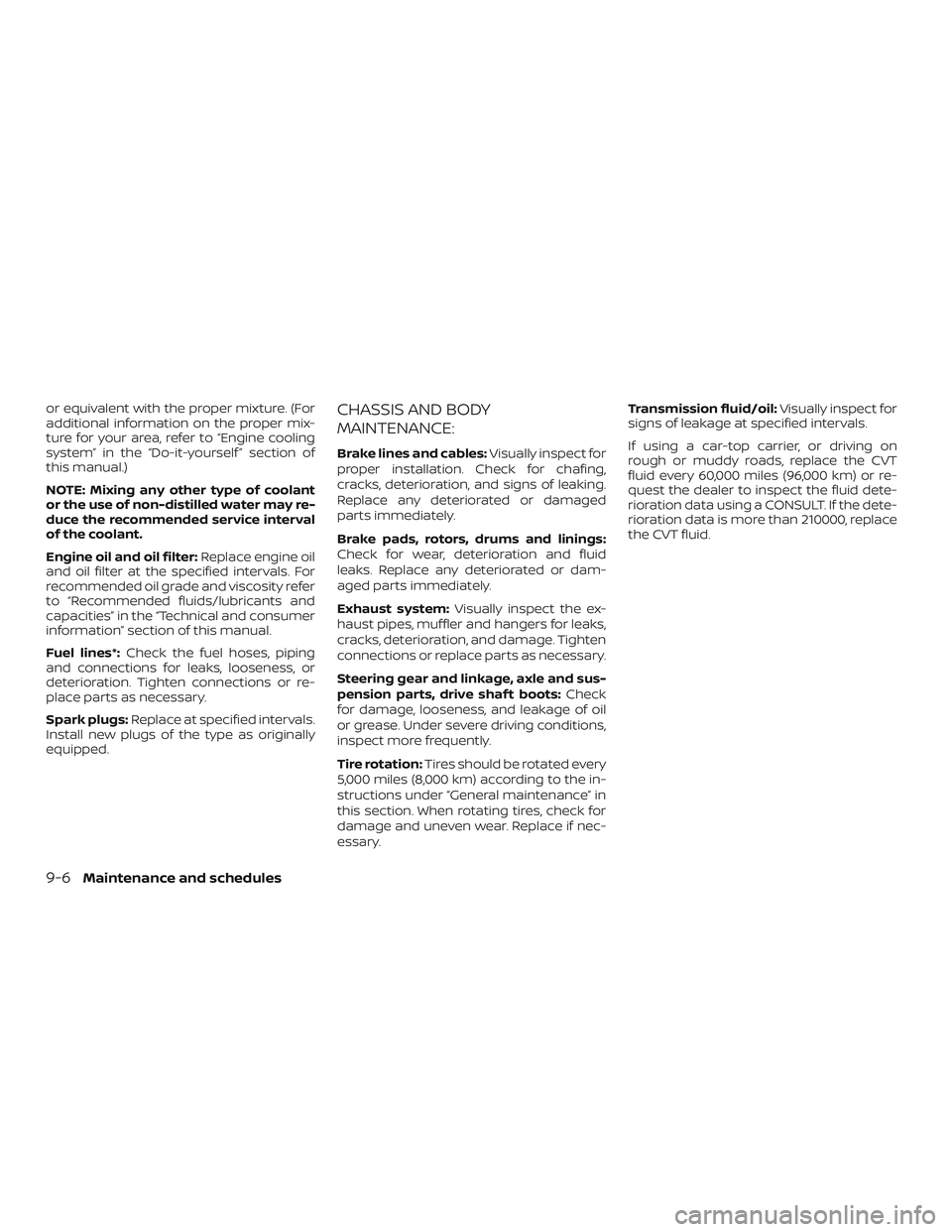
or equivalent with the proper mixture. (For
additional information on the proper mix-
ture for your area, refer to “Engine cooling
system” in the “Do-it-yourself ” section of
this manual.)
NOTE: Mixing any other type of coolant
or the use of non-distilled water may re-
duce the recommended service interval
of the coolant.
Engine oil and oil filter:Replace engine oil
and oil filter at the specified intervals. For
recommended oil grade and viscosity refer
to “Recommended fluids/lubricants and
capacities” in the “Technical and consumer
information” section of this manual.
Fuel lines*: Check the fuel hoses, piping
and connections for leaks, looseness, or
deterioration. Tighten connections or re-
place parts as necessary.
Spark plugs: Replace at specified intervals.
Install new plugs of the type as originally
equipped.CHASSIS AND BODY
MAINTENANCE:
Brake lines and cables: Visually inspect for
proper installation. Check for chafing,
cracks, deterioration, and signs of leaking.
Replace any deteriorated or damaged
parts immediately.
Brake pads, rotors, drums and linings:
Check for wear, deterioration and fluid
leaks. Replace any deteriorated or dam-
aged parts immediately.
Exhaust system: Visually inspect the ex-
haust pipes, muffler and hangers for leaks,
cracks, deterioration, and damage. Tighten
connections or replace parts as necessary.
Steering gear and linkage, axle and sus-
pension parts, drive shaf t boots: Check
for damage, looseness, and leakage of oil
or grease. Under severe driving conditions,
inspect more frequently.
Tire rotation: Tires should be rotated every
5,000 miles (8,000 km) according to the in-
structions under “General maintenance” in
this section. When rotating tires, check for
damage and uneven wear. Replace if nec-
essary. Transmission fluid/oil:
Visually inspect for
signs of leakage at specified intervals.
If using a car-top carrier, or driving on
rough or muddy roads, replace the CVT
fluid every 60,000 miles (96,000 km) or re-
quest the dealer to inspect the fluid dete-
rioration data using a CONSULT. If the dete-
rioration data is more than 210000, replace
the CVT fluid.
9-6Maintenance and schedules
Page 407 of 444
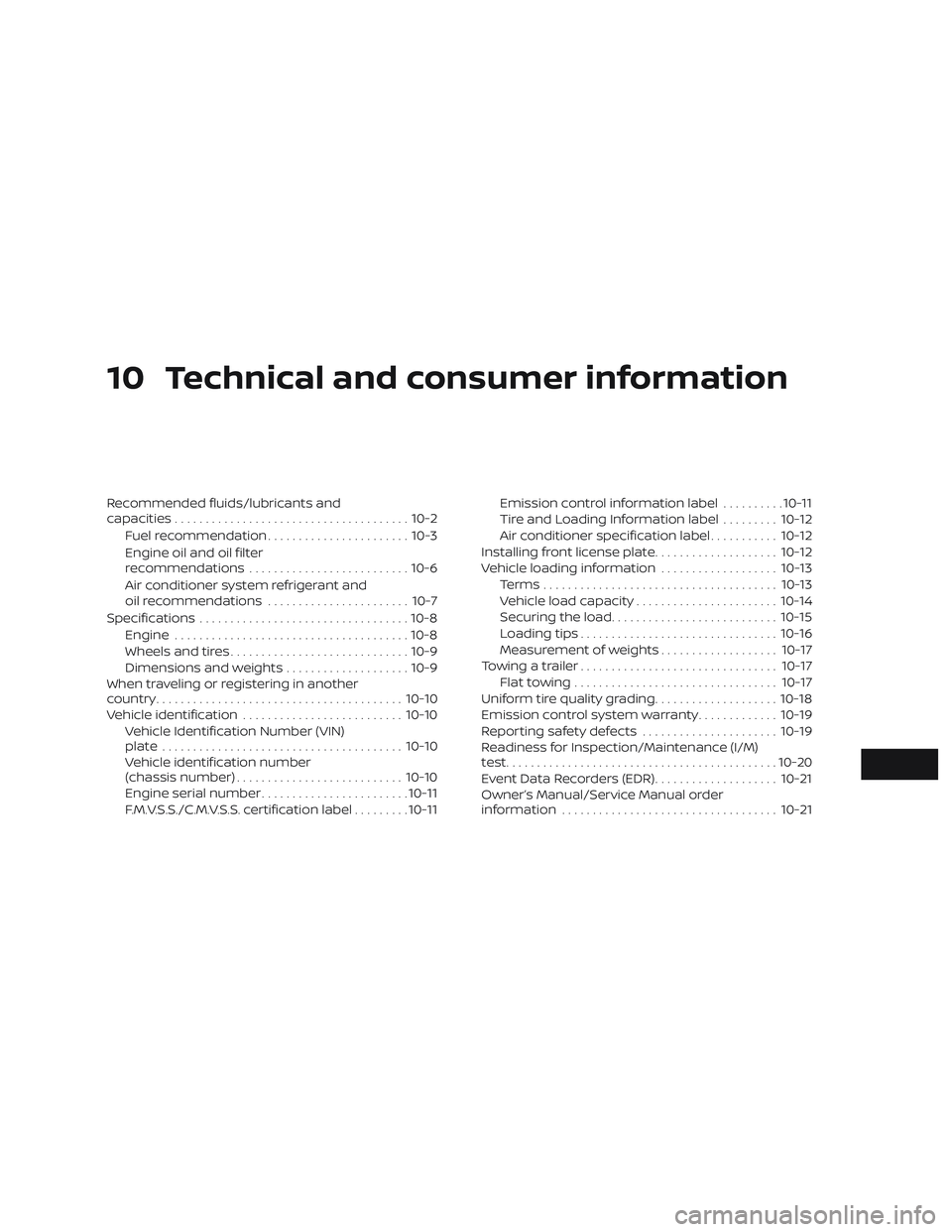
10 Technical and consumer information
Recommended fluids/lubricants and
capacities...................................... 10-2
Fuel recommendation ....................... 10-3
Engine oil and oil filter
recommendations .......................... 10-6
Air conditioner system refrigerant and
oil recommendations ....................... 10-7
Specifications .................................. 10-8
Engine ...................................... 10-8
Wheels and tires ............................. 10-9
Dimensions and weights ....................10-9
When traveling or registering in another
country ........................................ 10-10
Vehicle identification .......................... 10-10
Vehicle Identification Number (VIN)
plate ....................................... 10-10
Vehicle identification number
(chassis number) ........................... 10-10
Engine serial number ........................ 10-11
F.M.V.S.S./C.M.V.S.S. certification label .........10-11 Emission control information label
..........10-11
Tire and Loading Information label .........10-12
Air conditioner specification label ...........10-12
Installing front license plate ....................10-12
Vehicle loading information ...................10-13
Terms ...................................... 10-13
Vehicle load capacity ....................... 10-14
Securing the load ........................... 10-15
Loading tips ................................ 10-16
Measurement of weights ...................10-17
Towing a trailer ................................ 10-17
Flat towing ................................. 10-17
Uniform tire quality grading ....................10-18
Emission control system warranty .............10-19
Reporting safety defects ......................10-19
Readiness for Inspection/Maintenance (I/M)
test ............................................ 10-20
Event Data Recorders (EDR) ....................10-21
Owner’s Manual/Service Manual order
information ................................... 10-21
Page 415 of 444
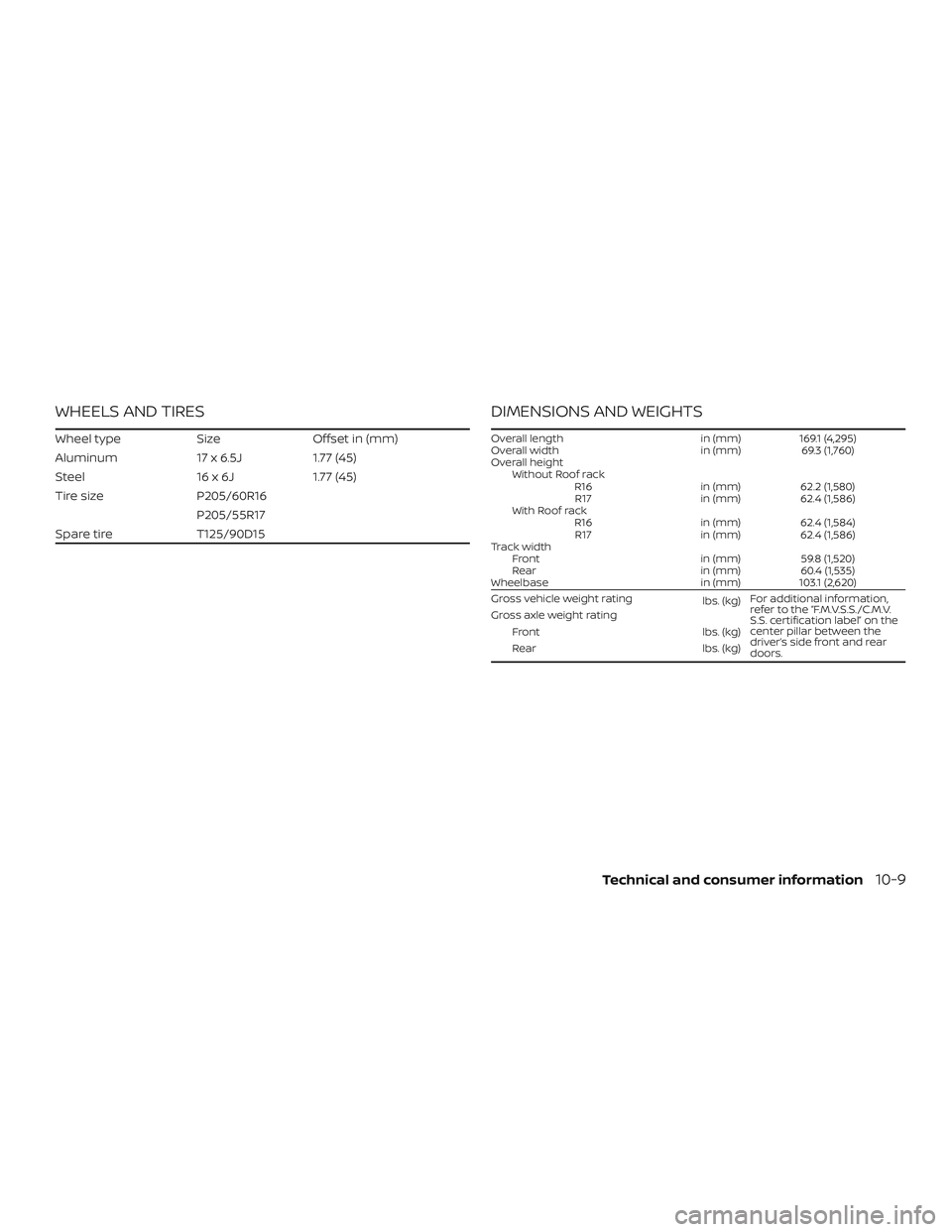
WHEELS AND TIRES
Wheel typeSizeOffset in (mm)
Aluminum 17 x 6.5J1.77 (45)
Steel 16 x 6J1.77 (45)
Tire size P205/60R16
P205/55R17
Spare tire T125/90D15
DIMENSIONS AND WEIGHTS
Overall length in (mm)169.1 (4,295)
Overall width in (mm)69.3 (1,760)
Overall height Without Roof rack R16 in (mm)62.2 (1,580)
R17 in (mm)62.4 (1,586)
With Roof rack R16 in (mm)62.4 (1,584)
R17 in (mm)62.4 (1,586)
Track width Front in (mm)59.8 (1,520)
Rear in (mm)60.4 (1,535)
Wheelbase in (mm)103.1 (2,620)
Gross vehicle weight rating lbs. (kg)For additional information,
refer to the “F.M.V.S.S./C.M.V.
S.S. certification label” on the
center pillar between the
driver’s side front and rear
doors.
Gross axle weight rating
Front lbs. (kg)
Rear lbs. (kg)
Technical and consumer information10-9
Page 421 of 444
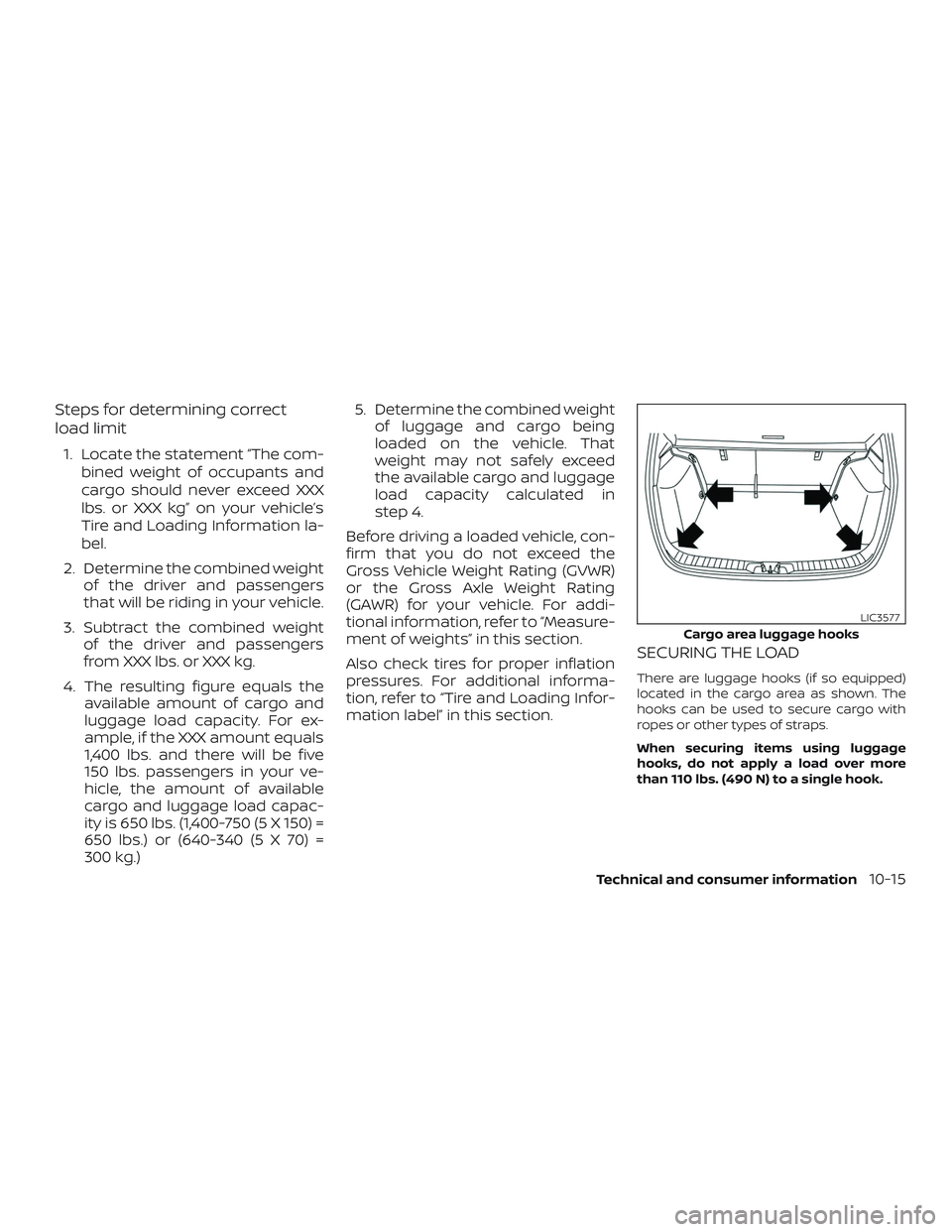
Steps for determining correct
load limit
1. Locate the statement “The com-bined weight of occupants and
cargo should never exceed XXX
lbs. or XXX kg” on your vehicle’s
Tire and Loading Information la-
bel.
2. Determine the combined weight of the driver and passengers
that will be riding in your vehicle.
3. Subtract the combined weight of the driver and passengers
from XXX lbs. or XXX kg.
4. The resulting figure equals the available amount of cargo and
luggage load capacity. For ex-
ample, if the XXX amount equals
1,400 lbs. and there will be five
150 lbs. passengers in your ve-
hicle, the amount of available
cargo and luggage load capac-
ity is 650 lbs. (1,400-750 (5 X 150) =
650 lbs.) or (640-340 (5 X 70) =
300 kg.) 5. Determine the combined weight
of luggage and cargo being
loaded on the vehicle. That
weight may not safely exceed
the available cargo and luggage
load capacity calculated in
step 4.
Before driving a loaded vehicle, con-
firm that you do not exceed the
Gross Vehicle Weight Rating (GVWR)
or the Gross Axle Weight Rating
(GAWR) for your vehicle. For addi-
tional information, refer to “Measure-
ment of weights” in this section.
Also check tires for proper inflation
pressures. For additional informa-
tion, refer to “Tire and Loading Infor-
mation label” in this section.
SECURING THE LOAD
There are luggage hooks (if so equipped)
located in the cargo area as shown. The
hooks can be used to secure cargo with
ropes or other types of straps.
When securing items using luggage
hooks, do not apply a load over more
than 110 lbs. (490 N) to a single hook.
Cargo area luggage hooks
LIC3577
Technical and consumer information10-15
Page 423 of 444
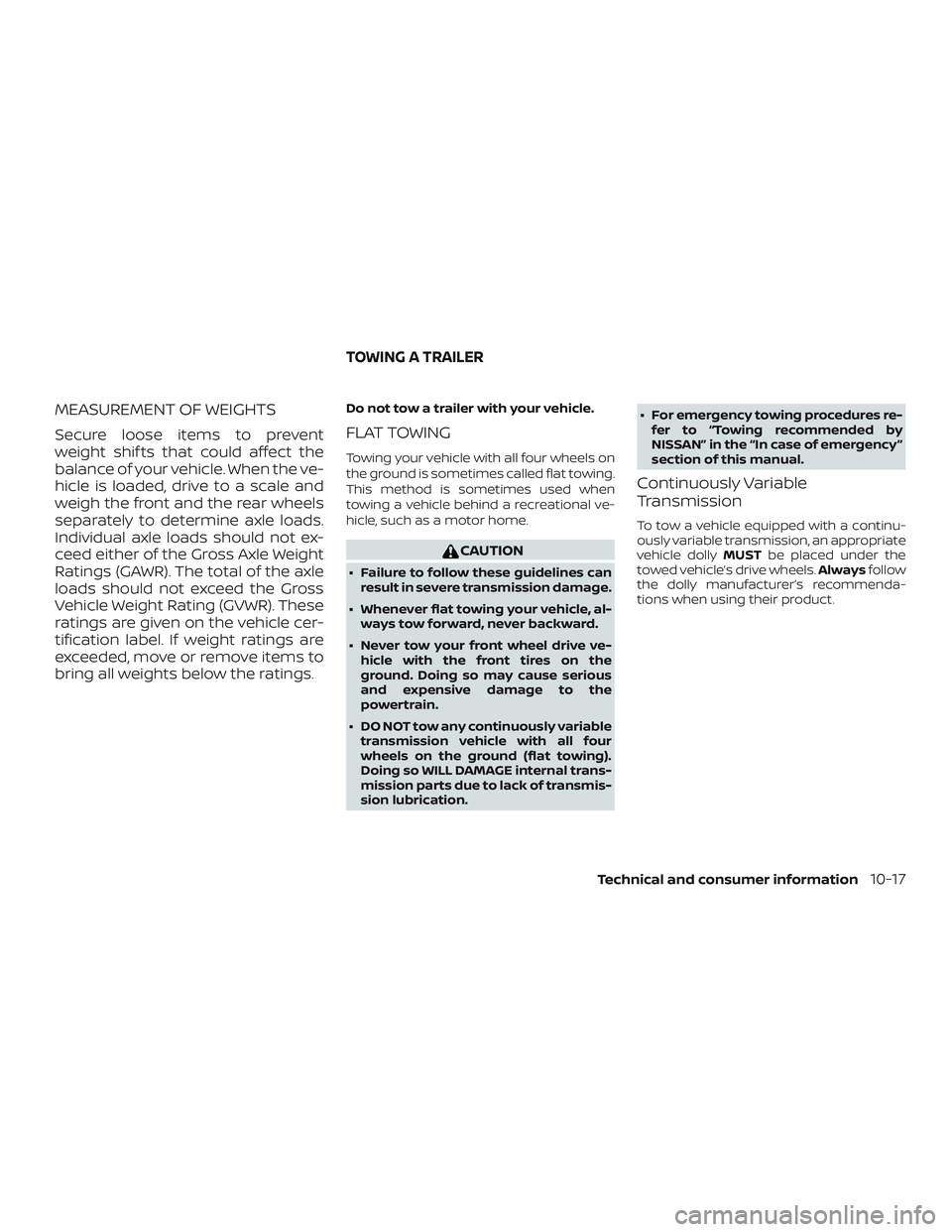
MEASUREMENT OF WEIGHTS
Secure loose items to prevent
weight shif ts that could affect the
balance of your vehicle. When the ve-
hicle is loaded, drive to a scale and
weigh the front and the rear wheels
separately to determine axle loads.
Individual axle loads should not ex-
ceed either of the Gross Axle Weight
Ratings (GAWR). The total of the axle
loads should not exceed the Gross
Vehicle Weight Rating (GVWR). These
ratings are given on the vehicle cer-
tification label. If weight ratings are
exceeded, move or remove items to
bring all weights below the ratings.
Do not tow a trailer with your vehicle.
FLAT TOWING
Towing your vehicle with all four wheels on
the ground is sometimes called flat towing.
This method is sometimes used when
towing a vehicle behind a recreational ve-
hicle, such as a motor home.
CAUTION
∙ Failure to follow these guidelines canresult in severe transmission damage.
∙ Whenever flat towing your vehicle, al- ways tow forward, never backward.
∙ Never tow your front wheel drive ve- hicle with the front tires on the
ground. Doing so may cause serious
and expensive damage to the
powertrain.
∙ DO NOT tow any continuously variable transmission vehicle with all four
wheels on the ground (flat towing).
Doing so WILL DAMAGE internal trans-
mission parts due to lack of transmis-
sion lubrication. ∙ For emergency towing procedures re-
fer to “Towing recommended by
NISSAN” in the “In case of emergency ”
section of this manual.
Continuously Variable
Transmission
To tow a vehicle equipped with a continu-
ously variable transmission, an appropriate
vehicle dolly MUSTbe placed under the
towed vehicle’s drive wheels. Alwaysfollow
the dolly manufacturer’s recommenda-
tions when using their product.
TOWING A TRAILER
Technical and consumer information10-17
Page 424 of 444

DOT (Department of Transportation) Qual-
ity Grades: All passenger car tires must
conform to federal safety requirements in
addition to these grades.
Quality grades can be found where appli-
cable on the tire sidewall between tread
shoulder and maximum section width. For
example:
Treadwear 200 Traction AA Temperature
A
Treadwear
The treadwear grade is a comparative rat-
ing based on the wear rate of the tire when
tested under controlled conditions on a
specified government test course. For ex-
ample, a tire graded 150 would wear one
and one-half (1 1/2) times as well on the
government course as a tire graded 100.
The relative performance of tires depends
upon the actual conditions of their use,
however, and may depart significantly from
the norm due to variations in driving habits,
service practices and differences in road
characteristics and climate.
Traction AA, A, B and C
The traction grades, from highest to low-
est, are AA, A, B, and C. Those grades repre-
sent the tire’s ability to stop on wet pave-ment as measured under controlled
conditions on specified government test
surfaces of asphalt and concrete. A tire
marked C may have poor traction perfor-
mance.
WARNING
The traction grade assigned to this tire
is based on straight-ahead braking
traction tests, and does not include ac-
celeration, cornering, hydroplaning, or
peak traction characteristics.
Temperature A, B and C
The temperature grades are A (the high-
est), B, and C, representing the tire’s resis-
tance to the generation of heat, and its
ability to dissipate heat when tested under
controlled conditions on a specified indoor
laboratory test wheel. Sustained high tem-
perature can cause the material of the tire
to degenerate and reduce tire life, and ex-
cessive temperature can lead to sudden
tire failure. The grade C corresponds to a
level of performance which all passenger
car tires must meet under the Federal Mo-
tor Vehicle Safety Standard No. 109. Grades
B and A represent higher levels of perfor-
mance on the laboratory test wheel than
the minimum required by law.
WARNING
The temperature grade for this tire is
established for a tire that is properly in-
flated and not overloaded. Excessive
speed, under-inflation, or excessive
loading, either separately or in combi-
nation, can cause heat build-up and
possible tire failure.
UNIFORM TIRE QUALITY GRADING
10-18Technical and consumer information
Page 434 of 444
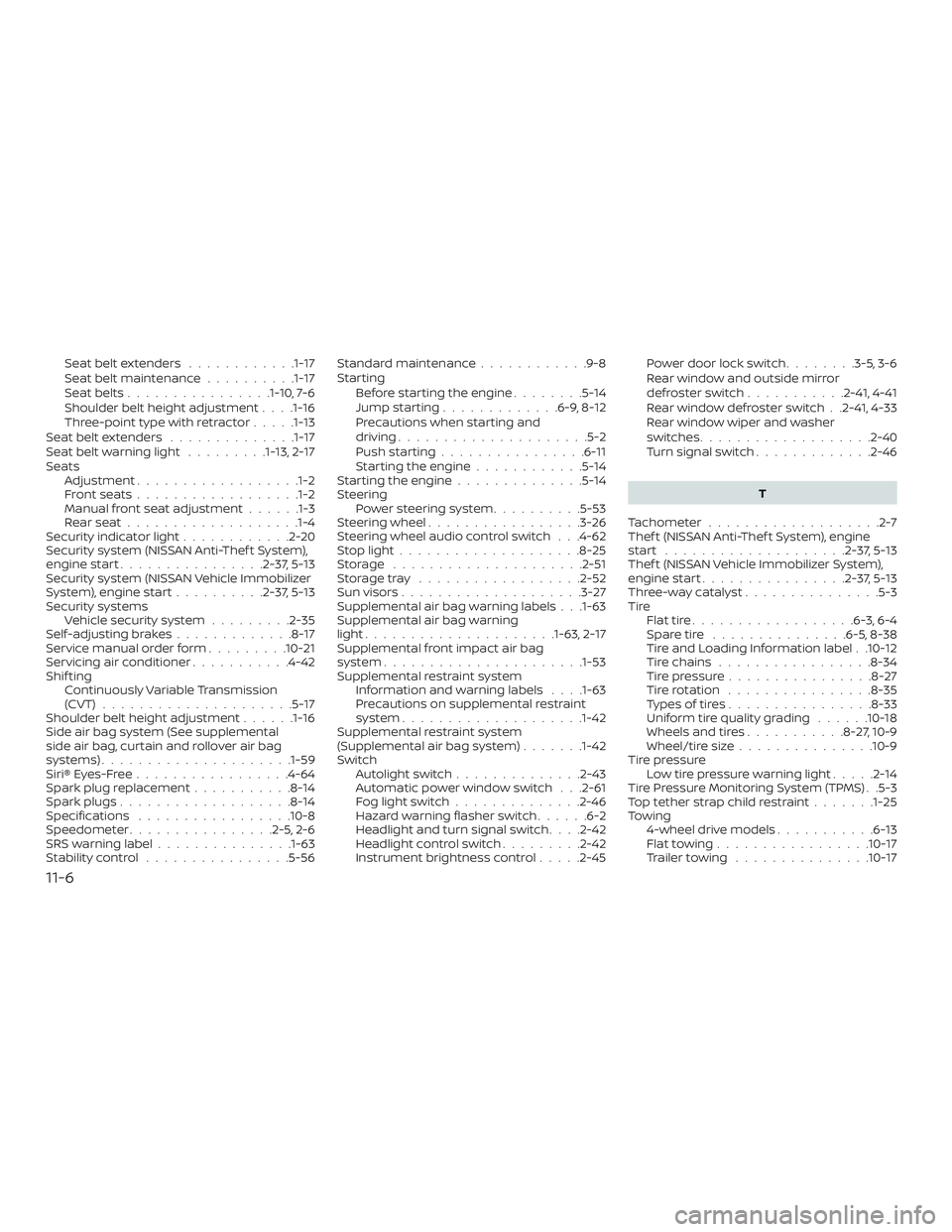
Seat belt extenders............1-17
Seat belt maintenance ..........1-17
Seatbelts................1-10, 7-6
Shoulder belt height adjustment . . . .1-16
Three-pointtypewithretractor.....1-13
Seat belt extenders ..............1-17
Seatbeltwarninglight .........1-13, 2-17
Seats Adjustment ..................1-2
Frontseats..................1-2
Manual front seat adjustment ......1-3
Rearseat.................. .1-4
Security indicator light ............2-20
Security system (NISSAN Anti-Thef t System),
engine start ................2-37,5-13
Security system (NISSAN Vehicle Immobilizer
System), engine start ..........2-37,5-13
Security systems Vehicle security system .........2-35
Self-adjustingbrakes.............8-17
Service manual order form .........10-21
Servicing air conditioner ...........4-42
Shif ting Continuously Variable Transmission
(CVT) .....................5-17
Shoulder belt height adjustment ......1-16
Side air bag system (See supplemental
side air bag, curtain and rollover air bag
systems) .................... .1-59
Siri® Eyes-Free .................4-64
Spark plug replacement ...........8-14
Spark plugs ...................8-14
Specifications .................10-8
Speedometer ................2-5,2-6
SRS warning label ...............1-63
Stability control ................5-56 Standard maintenance
............9-8
Starting Before starting the engine ........5-14
Jumpstarting.............6-9,8-12
Precautions when starting and
driving.....................5-2
Push starting ................6-11
Starting the engine ............5-14
Starting the engine ..............5-14
Steering Powersteeringsystem..........5-53
Steering wheel .................3-26
Steering wheel audio control switch . . .4-62
Stoplight....................8-25
Storage .....................2-51
Storagetray ..................2-52
Sunvisors....................3-27
Supplemental air bag warning labels . . .1-63
Supplemental air bag warning
light.................... .1-63, 2-17
Supplemental front impact air bag
system ..................... .1-53
Supplemental restraint system Information and warning labels . . . .1-63
Precautions on supplemental restraint
system ................... .1-42
Supplemental restraint system
(Supplemental air bag system) .......1-42
Switch Autolightswitch..............2-43
Automatic power window switch . . .2-61
Foglightswitch..............2-46
Hazard warning flasher switch ......6-2
Headlight and turn signal switch ....2-42
Headlightcontrolswitch.........2-42
Instrument brightness control .....2-45Power door lock switch
........3-5 , 3-6
Rear window and outside mirror
defrosterswitch...........2-41,4-41
Rear window defroster switch . .2-41, 4-33
Rear window wiper and washer
switches ...................2-40
Turn signal switch .............2-46
T
Tachometer ...................2-7
Thef t (NISSAN Anti-Thef t System), engine
start ....................2-37,5-13
Thef t (NISSAN Vehicle Immobilizer System),
engine start ................2-37,5-13
Three-waycatalyst...............5-3
Tire Flattire..................6-3,6-4
Spare tire ...............6-5,8-38
Tire and Loading Information label . .10-12
Tire chains .................8-34
Tire pressure ................8-27
Tirerotation ................8-35
Types of tires ................8-33
Uniform tire quality grading ......10-18
Wheels and tires ...........8-27,10-9
Wheel/tire size ...............10-9
Tire pressure Low tire pressure warning light .....2-14
Tire Pressure Monitoring System (TPMS) . .5-3
Toptetherstrapchildrestraint.......1-25
Towing 4-wheel drive models ...........6-13
Flattowing.................10-17
Trailertowing ...............10-17
11-6
Page 435 of 444
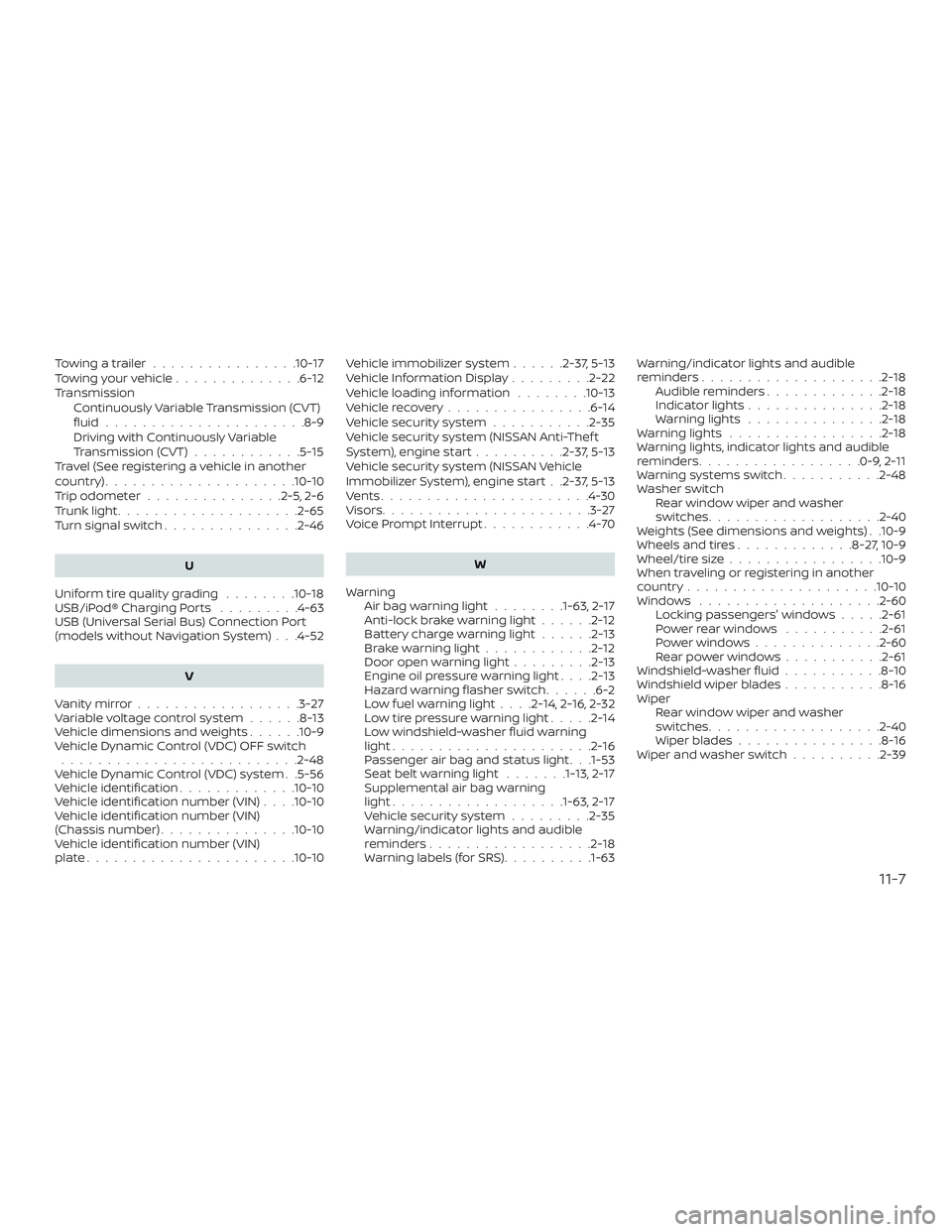
Towingatrailer................10-17
Towingyourvehicle..............6-12
TransmissionContinuously Variable Transmission (CVT)
fluid......................8-9
Driving with Continuously Variable
Transmission (CVT) ............5-15
Travel (See registering a vehicle in another
country) .....................10-10
Trip odometer ...............2-5,2-6
Trunklight....................2-65
Turn signal switch ...............2-46
U
Uniform tire quality grading ........10-18
USB/iPod® Charging Ports .........4-63
USB (Universal Serial Bus) Connection Port
(models without Navigation System) . . .4-52
V
Vanitymirror..................3-27
Variable voltage control system ......8-13
Vehicle dimensions and weights ......10-9
Vehicle Dynamic Control (VDC) OFF switch ..........................2-48
Vehicle Dynamic Control (VDC) system . .5-56
Vehicle identification .............10-10
Vehicle identification number (VIN) . . . .10-10
Vehicle identification number (VIN)
(Chassis number) ...............10-10
Vehicle identification number (VIN)
plate.......................10-10 Vehicle immobilizer system
......2-37,5-13
VehicleInformationDisplay.........2-22
Vehicle loading information ........10-13
Vehiclerecovery................6-14
Vehicle security system ...........2-35
Vehicle security system (NISSAN Anti-Thef t
System), engine start ..........2-37,5-13
Vehicle security system (NISSAN Vehicle
Immobilizer System), engine start . .2-37, 5-13
Vents.......................4-30
Visors.......................3-27
Voice Prompt Interrupt ............4-70
W
Warning Airbagwarninglight........1-63, 2-17
Anti-lock brake warning light ......2-12
Battery charge warning light ......2-13
Brakewarninglight............2-12
Door open warning light .........2-13
Engine oil pressure warning light ....2-13
Hazard warning flasher switch ......6-2
Lowfuelwarninglight....2-14,2-16,2-32
Lowtirepressurewarninglight.....2-14
Low windshield-washer fluid warning
light......................2-16
Passenger air bag and status light . . .1-53
Seatbeltwarninglight .......1-13, 2-17
Supplemental air bag warning
light.................. .1-63, 2-17
Vehicle security system .........2-35
Warning/indicator lights and audible
reminders ..................2-18
Warning labels (for SRS) ..........1-63Warning/indicator lights and audible
reminders
....................2-18
Audible reminders .............2-18
Indicatorlights...............2-18
Warninglights ...............2-18
Warninglights .................2-18
Warning lights, indicator lights and audible
reminders ..................0-9,2-11
Warningsystemsswitch...........2-48
Washer switch Rear window wiper and washer
switches ................... 2-40
Weights (See dimensions and weights) . .10-9
Wheels and tires .............8-27,10-9
Wheel/tire size .................10-9
When traveling or registering in another
country .....................10-10
Windows ................... .2-60
Locking passengers' windows .....2-61
Powerrearwindows ...........2-61
Powerwindows..............2-60
Rearpowerwindows...........2-61
Windshield-washer fluid ...........8-10
Windshield wiper blades ...........8-16
Wiper Rear window wiper and washer
switches ................... 2-40
Wiper
blades ................8-16
Wiper and washer switch ..........2-39
11-7